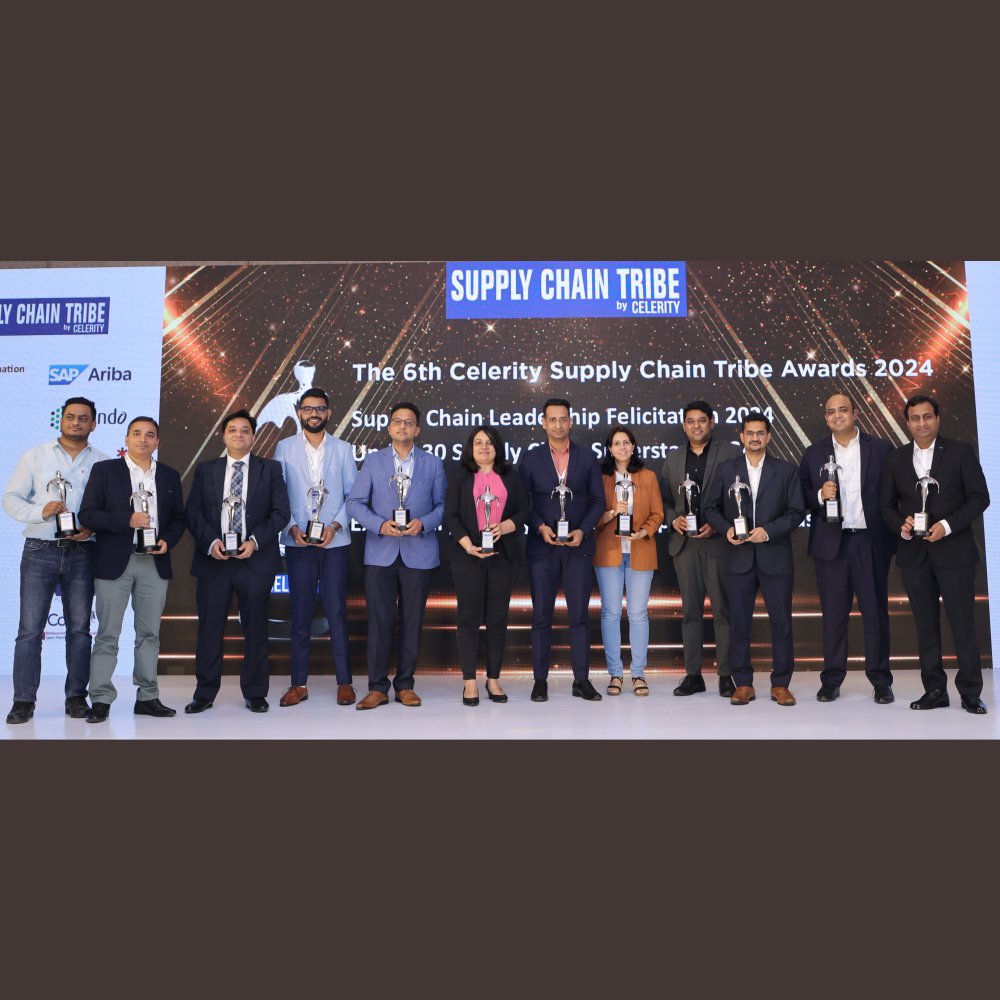Honouring & celebrating the achievements and the power performance of new age supply chain managers and future leaders has been the hallmark of Celerity Supply Chain Awards since inception.
Continuing the tradition, the 6th edition of Celerity Supply Chain Awards once again takes pride in presenting the supply chain vanguards who have led the charge n supply chain innovation and excellence and driven transformative changes. With unparalleled expertise and forward-thinking strategies, they shape the future of global logistics and operations. Thoroughly vetted based on a strict nomination criterion by a stellar set of senior jury members, these awards have proven to create a strong & superior league of future supply chain leaders and their achievements & innovations only complement our strict & nuanced judging process. Here’s presenting the thought-provoking innovations successfully achieved by our Under 40 Celerity Supply Chain Super Achievers 2024.
Abhishek Yadav, VP – Operations & IT, Coldman Logistics Pvt Ltd.
Problem statement: We encountered significant challenges with inventory wastage and improper procurement planning for a pan-India client in the QSR segment. There was prolonged lead time for inventory delivery at various DCs as well as high SCM cost in order to maintain the adequate inventory levels at stores. All of this eventually led to business impact at the QSR outlet level.
Challenges faced: Delayed documentation, improper procurement planning and inventory management.
Approach and Implementation: We studied and made a comprehensive analysis of the business cycle for each distribution center, focusing on inventory cycle days and replenishment cycles, and documented all challenges encountered throughout the business operations. We developed technological and data analysis solutions for each identified problem. Our team re-engineered the entire business operation into a Business Intelligence (BI) tool-based software, we named it TARS (The Advanced Retailing Software). The software integrated Warehouse Management System (WMS) data and applied an inventory forecast model based on the Stock in Hand (SIH) inventory report and physical inventory available at the warehouse. It automatically triggers purchase order (PO) quantities, generates POs, and sends them to the procurement manager for approval. Upon approval, the POs are automatically forwarded to vendors.
Outcome: The organization has reaped the benefit of the tool in terms of increased efficiency, streamlined business operations and we received accolades from the brand, resulting into increased business from the brand.
Ajay Kumar, Chief Purchasing Officer, MT Autocraft Group
A leading automobile company operates with its JIT material procurement, maintaining minimal inventory levels of less than a shift’s production. Suppliers are tasked with delivering predefined quantities at specified times, managing all inventories themselves. Manually tracking supplier’s inventory and adjusting to production planning changes proved always the most challenging task for buyers.
To address these challenges, the company leveraged a shared IT platform to develop a Suppliers’ FG monitoring system. Collaborating with the IT team, a portal was created where suppliers could input daily opening FG stock levels. This system allowed Company buyers to remotely analyse data, supported by color coded thresholds for easy interpretation. Regular audits ensured data authenticity, enhancing transparency across the supply chain.
Additionally, a mobile app was designed for the SCM team, providing real-time updates on delivery and stock statuses. This facilitated remote monitoring and immediate response to any discrepancies.
The implementation of this system brought about significant benefits such as Enhanced Visibility, Improved Efficiency, Increased Transparency & Agility in Production Planning and it showcases how strategic technology integration can optimize supply chain operations, setting a new benchmark for efficiency and transparency in the automotive industry.
Ankit Singhai, Head – Packaging Procurement, Nestle India Ltd.
During my tenure as the Factory Supply Chain Manager, my team and I accomplished significant achievements in addressing the challenges posed by an influx of contractual manpower and the formation of a union seeking permanent status within the company. While the ER/IR team was engaged on the issue, we were tasked with critically evaluating all work streams and identifying opportunities for automation to reduce dependency on contractual manpower. Together, we implemented several innovative, coordinated, and bold initiatives:
- Automated wheat flour tipping: Collaborating with corporate procurement and suppliers, we prepared a 1-year plan to move from wheat flour sourcing in bags (manual tipping) to Silo Tankers.
- Elimination of night shift unloading operations in warehouse by realigning activities in day shifts and coordinating with JIT material suppliers for deliveries on a strict slot-wise schedule, resulted in reduced waiting times and improved synchronization of operations.
- 100% palletized deliveries from suppliers through extensive collaboration with suppliers and support from Procurement, we successfully transitioned all incoming PM supplies to palletized loads. This enhanced turnaround time (TAT) and increased overall productivity.
- End-of-line automation: We developed a blueprint and received capex approval for installing palletizers at the end of the production line, thereby eliminating the need for contractual labor in manual filling operations.
These initiatives not only reduced reliance on contractual manpower but also improved operational efficiency and productivity. We were able to release 70 contractual workers who were absorbed into different capacities within the factory, ensuring that no jobs were lost while avoiding new hiring.
Deepak Kumar Goel, Chief of Operations, Last Mile, Shadowfax Technologies Pvt Ltd.
Shadowfax is a startup focused on e-commerce. It is the youngest in a very competitive industry. As we grew, we had to reach extreme internal pincodes of the country. Pincode coverage always comes with challenges of lower density as we go deeper into rural areas. This leads to higher fixed cost to open a facility with much lower volumes and higher load drop cost. Last mile success also depends largely on deep knowledge of the local market / people / area.
We implemented a hub & spoke model for distribution. We identified key demand centers to act as cross docks and created a tertiary distribution network. We identified clusters of 100 KM each to be served from these demand centers on tertiary distribution to lower our truck sizes saving significant cost and time. We initiated integration with local partners to run our operations on ground vs. opening our own facilities, lowering our fixed cost investment and increasing our on-ground knowledge.
As a result, we increased Shadowfax pincode coverage from 8500 to 18000 within a span of one year. We did this while still maintaining our best-in-class service and cost.
K V Srinivasa Rao, Factory Manager, Britannia Industries Ltd.
During my stint at GSK Consumer Healthcare Ltd., Horlicks manufacturing Process was semi-automatic and end of the line processes of tray handling & grinding was manual, posing threat to safety, food safety, wastages and cost escalation related issues.
Challenges Faced: Horlicks manufacturing has been happening since 1964 in India, but automation of the Tray Handling Process was never tested and there was no proven technology to completely automate the Tray handling process.
Approach: We identified technology experts through benchmarking, designed a prototype for the automatic tray handling, conducted trials & FATs at the vendor location, installed and commissioned the Auto Tray handling system at the Grinding sections.
Implementation: Through benchmarking, robotic automation was identified as the technology to automate the tray handling. All the key activities of Baked Horlicks tray unloading from trolley, tray tilting, tray feeding to grinder, tray tilting post grinding and then empty tray unloading to trolley are fully automated with zero manual intervention during the trials phase. Post the trials, the design was executed at the factory.
Outcome: The results of the innovation include:
- Safety Severity Risk Index & Food safety risk eliminated
- Handling wastages reduced by 0.5%
- Manpower headcount reduced by 15.3%
Latika Sharma, Head – Demand and Supply planning for Chocolates & Confectionery, Nestle India Ltd.
Problem Statement: As part of sustainable goals of Nestle, we were asked to establish end to end procurement, execution and monitoring of various types of biodigesters in farmer fields. spearheaded the planning and implementation of first-of-its-kind Biodigesters in Nestle India to utilize the waste of Cow Dung to generate fuel and electricity for farmers working with Nestle.
Challenges faced: This was a first of its kind initiative in Nestle and the processes/rules of the implementation were unknown. The biggest challenge faced was involvement of multiple parties (biodigester solution provider, farmer, Nestle India, civil works contractor) which led to increased difficulty in establishing the value chain, RACI and implementation. The target was to complete 3000+ installations by certain timeline and we started the work 4 months before this deadline with a stretched target.
Approach: A thorough level of detailed planning was done to identify various steps that would be undertaken in executing such a large project. All of it was put under contract detailing with the solution provider. Since the time available was less, various steps were optimized for parallel vs sequential implementation (example identification of farmers, pit digging, and trainings were done in parallel). There were weekly run rate reviews to understand the landing with the management committee of Nestle India.
Outcome: We were able to successfully achieve and implement 3000+ biodigesters in the country within the given period of short time. We were also able to establish cost discovery of such an innovative project and benchmarked it with other companies.
Mohammad Javed Husen, Mill Logistics & Supply Planning Manager - Malaysia & Singapore, Kimberly-Clark (Malaysia)
Background & Problem statement: ~50% of KCP India volume is imported with average 8-11 days of custom clearance time including Legal Metrology compliance (pasting stickers on each inner box) at CFS (container freight station) via opening of each case and pasting sticker on each inner box. The stickering activity was performance by CHA and charge for sticker & stickering. The process was time consuming, and we used to pay lots of money to CHA.
Opportunity: Reduction in custom clearance time and cost.
Action: We started formal discussions with CHAs & Custom officials for potential solutions with a view to reduce the clearance time. We also consulted with KC Legal team for India Legal Metrology compliance. Post discussion with both, we arrived at a conclusion that KCP is a B2B company, and their selling unit is case and not the inner box, hence we can avoid the LM stickering activity, which we were doing at CFS, which led to reduction of time by 2 to 3 days. Moreover, CHA advised us to go for a DPD (direct port delivery) facility offered by custom, which have skipped the material movement via CFS (another 2-3 days of savings) and finally taking AEO (Authorized Economic operator) T2 certification which enabled us to do duty payment once in 15 days instead of every shipment.
Result achieved: The whole exercise resulted in ~$1Mn+ sales loss avoidance due to fast shipment clearance via DPD which arrive during month end. We were able to achieve ~40% cost reduction in custom clearance & shipping line charges ~$100k annual, ~80% reduction in clearance days (from 10 to 2) and ~5% help for OTIF.
Neha Sorathia, Former Director-Supply Planning and Operational Excellence, PVH Corp
One of the most impactful Supply Chain Management (SCM) innovations I spearheaded was implementing a supplier collaboration platform at a Fortune 500 retail organization. The problem statement revolved around the need for more visibility into our supply chain operations, leading to inefficiencies and disruptions in production and distribution. Challenges included limited visibility, operational inefficiencies, and delays in identifying and resolving supply chain disruptions.
We implemented a supplier collaboration platform with robust analytics capabilities to address these challenges. Data from ERP systems, manufacturing facilities, logistics partners, and suppliers was vital, allowing for comprehensive visibility. The team built customized dashboards to visualize key performance indicators (KPIs) and supply chain metrics.
The outcome was transformative… Enhanced visibility enabled proactive issue resolution, leading to improved decision-making and reduced lead times. This optimization resulted in reduced expediting costs and minimized inventory holding costs. Additionally, smoother operations and timely order fulfilment improved customer service levels.
Nupur Arora, Head – Customer Supply Chain (E-commerce), Nestle India Ltd.
My management philosophy centres around leading with authenticity, humility, and a profound belief in people’s potential. I firmly believe that attitude is everything. By setting an example through my actions, actively listening to my team, and offering unwavering support, I create an environment where everyone feels valued and motivated. This fosters a culture of empowerment, collaboration, and continuous growth, where each team member can unleash their full potential. Open communication, transparency, and accountability are non-negotiables, as they lay the foundation for trust and success. Ultimately, my mantra is to lead with empathy, inspiring greatness in others, while relentlessly pursuing excellence in every endeavour.
Pradeep Ramesh Billava, Vice President, Zepto
Problem Statement: During my previous stint at Pepperfry, challenges with big box furniture delivery included incomplete shipments and the absence of assembly services, deterring online purchases.
Challenges Faced: Vendors struggled with multi-box logistics, leading to delivery mismatches. Additionally, delivery staff lacked experience in verifying items during open-box deliveries, and there was no nationwide network of carpenters for assembly.
Approach and Implementation: We revamped logistics by investing in a warehouse management system and a sourcing center to manage SKU transitions effectively. We equipped delivery supervisors with scanning technology to ensure correct shipments and implemented a training program focusing on customer safety and delivery protocols. We also established a digital platform for carpenters, providing them with assembly manuals and a system to request spare parts as needed.
Outcome: This initiative resulted in a 98% on-time delivery rate within 48 hours and a 90% rate of same-day assembly, enhancing customer satisfaction and significantly boosting our market share. By solving logistical and service challenges, we enhanced operational efficiency and positioned our company as a leader in the furniture e-commerce sector.
Santosh Kumar Wagh, Senior Manager – Supplier Development-Sourcing, Walmart Global Sourcing India Pvt Ltd.
Problem Statement: In my previous organization, we set out our vision to develop a cold supply chain system that ensures an efficient and environmentally friendly transpiration, storage and distribution of temperature sensitive goods.
Challenges faced: We were importing temperature sensitive RLD drugs for R&D purposes and it needed to be stored and distributed during several interval of times. High temperature sensitivity resulted in operational difficulties like frequent ordering (energy consumption), stock-outs (product damage resulting in waste), frequent deliveries (increase in emissions) and no. of people to manage.
Approach: We did a comprehensive assessment of the existing cold supply chain to identify areas of improvement in energy efficiency, emissions reduction, waste management and resource utilization.
- Set clear sustainability goal: Define specific, measurable and achievable goals for the cold supply chain such as reducing carbon emissions and minimizing waste.
- Technology adoption: Implement advanced technologies like IoT sensors, data analytics and automation to monitor temperature, humidity and other environmental conditions in real time
- Partnerships: Collaboration with suppliers, manufacturers and logistics providers to share best practices and implement initiatives.
Implementation: With above approach, following ways implemented a solution:
- Suppliers: Negotiated agreements to secure stocks at their end.
- Logistics providers: Negotiated agreements to consolidate products at central location (route optimization) and maintain into their dedicated cold warehouses.
- Implemented regulatory compliance acceptable re-usable data logger monitoring from source to destination.
- Shifting to dry ice packaging from gel packs reducing carbon footprint.
Siddharth Anand, Associate Director, Tata Consumer Products
During my stint at MTR Foods, a unique supply chain was setup for MTR’s fresh batter business where operating the daily fresh supplies of Batter for Bangalore city was done from one factory and three distribution centres. Cold trucks from factory would reach the DCs early morning to unload stocks in the cold rooms at the DCs.
From here, the distribution to retail was done with delivery boys on two-wheelers who would go with ready stocks supported by a sophisticated billing system capable of sales as well as returns collection. The two wheelers were modified and customized insulated bags were designed after lots of trials which would give each delivery person the capability of carrying stocks equivalent to at least 5k of sales value per day. We started with a fleet of 50 two wheelers and kept on expanding till we reached scale to be able to start service using higher capacity delivery vans.
The learnings in setting up this supply chain were enormous - planning as well as logistics - both had its own challenges which we navigated as a team and emerged victorious. Today MTR is giving tough competition to the old & stable ID Foods brand in Bangalore and the fresh business which has now expanded to a range of SKUs has emerged as a strong pillar of growth for MTR.
Vivek Mehta, Vertical Head (Senior Manager) – Organized Trade, Nivea India
During my previous stint at L’Oréal, India, I was tasked to build e-commerce SCM function as L’Oréal, India was one of the poorest performing regions for L’Oréal globally on the Amazon account, and one of the poorest ranked vendors for Amazon India. With the help of my team members, I turned around the function in 18 months by:
- Collaborating with Finance and Key Account Managers to create a reconciliation process on Amazon Vendor Central Portal resulting in payment recovery of over Rs 30MN
- Implementing EDI (Electronic Data Interchange) with IT team from PO receipt to payment leading to 50%+ reduction in invoice related disputes, and faster payments
- Creating a Supply Chain control tower (partnership with Accenture Consulting), and maintained 95%+ On Shelf Availability by acting on outputs from tools such as EDGE and Paxcomm, resulting in maintaining best in class Amazon reported metric Replenishable Out oof Stock at 6%
- Creating a tool in partnership with demand planning, Key Account Managers, Category Managers, and counterparts at Amazon (In Stock Managers and Vendor Managers) to forecast demand for Amazon great Indian Sale, resulting in 95% in stock event readiness, 96%+ fill rates
- Collaborated with demand planning team to review exceptions to forecast in account planning meetings, and pre-S&OP reviews, and supported ML/AI forecast through SIT data at E-tailer level. For this, team was honoured with Certificate of Recognition for Integrated Ecommerce Business Planning Process implementation.
These efforts led to 120% business growth in COVID-19, made Maybelline the No. 1 make-up brand, and L’Oréal Paris the No.1 hair serum brand on Amazon. These achievements were noted, and I was sent to Tokyo to train the APAC team (6+ countries) to train my counterparts on Amazon supply chain management and SOPs.

Categories

Magazine Editions






















